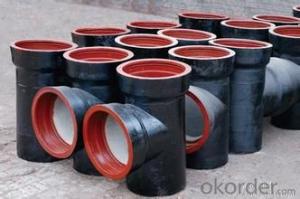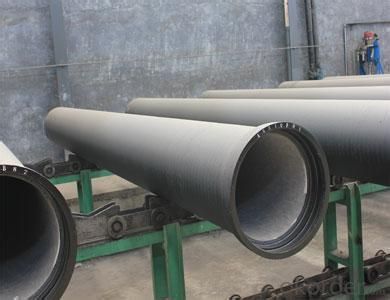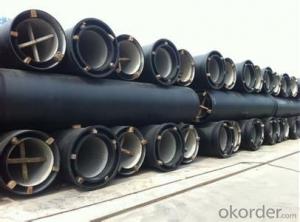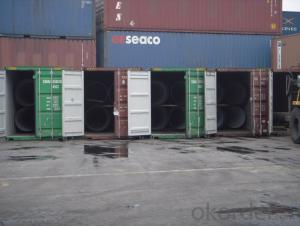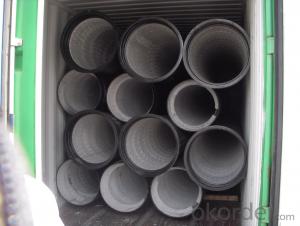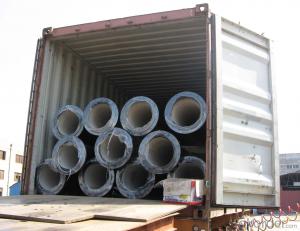DUCTILE IRON PIPES C Class DN200
- Loading Port:
- China Main Port
- Payment Terms:
- TT OR LC
- Min Order Qty:
- -
- Supply Capability:
- -
OKorder Service Pledge
OKorder Financial Service
You Might Also Like
Ductile Iron Cast Pipe is without any defects compare with tradition casting tech, which has many advantages particularly as follow:
(1) High density. In the "vertical upward casting" process, the melt iron of centre liquid column in center crystallizer is continuously feeding for volume shrinkage caused by condensation tube at outer circumference , which lead to be free of shrinkage porosity.
(2) High purity. When melt iron pouring, the mixed impurities such as gas, dross, sand grain which are lighter than melt iron could be eliminated at furnace mouth, its impossible to enter into the crystallizer through the channel, so the melt iron into the crystallizer is very pure.
(3) Strength with toughness. The cooling speed provided by continuous crystallizer is 30 times than sand casting and 5 times than centrifugal casting, and doesn't produce white iron, the eutectic cell volume of continuous cast iron is one eighth to one tenth compare with traditional cast iron. The density of graphite nodule in ductile iron can reach 300-700 pcs/mm2. Therefore, all reason above improve the strength and toughness of continuous cast iron.
(4) Free machining. The high speed cooling make the hardening phase (such as boride, steadite) not appear like reticular, massive or thick, but diffuse like fish bone and pane in shape, moreover, there are tiny graphite flakes inlaid hardening phase. It's free machining in BrinellHardness the range of 250-300HB. However, the Brinell Hardness of 250 is top limit to common metal materials.
(5) Uniform composition of tube wall. The convection mixing of liquid column caused by marching type drawing in crystallizer make the composition of tube wall well-distributed, and concentration gradient very little.
(6) High productivity. To the wall thickness of tube under 10mm, the speed of continuous casting is 1 meter/min, to the wall thickness of tube under 20mm, the speed of continuous casting is 0.5 meter/min, which is high efficiency that centrifugal or other casting tech couldn't reach.
- Q: Can ductile iron pipes be used in seismic zones?
- Indeed, in seismic zones, ductile iron pipes are suitable for use. These pipes possess remarkable strength and flexibility, enabling them to endure ground movement and seismic events. Their capacity to absorb and disperse the forces generated by earthquakes reduces the likelihood of pipe failure or harm. Moreover, ductile iron pipes have been effectively employed in seismic zones for numerous years, with their performance confirmed by various examinations and assessments. Nevertheless, adhering to the proper design and installation guidelines is crucial to guarantee the optimal operation and safety of ductile iron pipes in seismic zones.
- Q: Can ductile iron pipes be used for trenchless pipe rehabilitation methods?
- Trenchless pipe rehabilitation methods offer a way to repair or rehabilitate existing pipelines without the need for extensive excavation or trenching. In these methods, ductile iron pipes are often used due to their durability, strength, and resistance to corrosion. Various trenchless methods, such as pipe lining, pipe bursting, and slip lining, can be used to rehabilitate ductile iron pipes. These methods involve inserting a new lining or pipe inside the existing ductile iron pipe, which helps to extend its lifespan and improve its structural integrity. Ductile iron pipes are the preferred choice for trenchless rehabilitation because they can withstand the forces and pressures involved in the process, providing a reliable and long-lasting solution.
- Q: What is the difference between spheroidal graphite cast iron QT400-15 and QT400-15A? What does the A mean later?
- The front is the material grade, and the back of the A should have special requirements.
- Q: Can ductile iron pipes be used for underground storage of hazardous materials?
- No, ductile iron pipes should not be used for underground storage of hazardous materials. Ductile iron pipes are commonly used for water and sewage systems due to their durability and corrosion resistance. However, they are not designed to withstand the specific requirements and potential hazards associated with storing hazardous materials underground. When it comes to underground storage of hazardous materials, it is crucial to use materials that are specifically engineered to handle the chemical properties and potential risks associated with these substances. Specialized materials such as high-density polyethylene (HDPE) or fiberglass reinforced plastic (FRP) are commonly used for underground storage tanks due to their excellent chemical resistance and ability to maintain structural integrity over time. Using ductile iron pipes for such purposes may lead to corrosion, leaks, or even catastrophic failures, resulting in environmental contamination and potential harm to surrounding areas. Therefore, it is essential to consult with experts and adhere to applicable regulations and guidelines when selecting materials for underground storage of hazardous materials to ensure safety and prevent potential hazards.
- Q: How do ductile iron pipes handle thermal cycling in industrial applications?
- Ductile iron pipes are known for their exceptional ability to handle thermal cycling in industrial applications. Thermal cycling refers to the fluctuation in temperature that occurs during the operation of various industrial processes. These pipes are designed to withstand the stresses caused by thermal expansion and contraction, making them highly suitable for environments with significant temperature variations. One of the key characteristics of ductile iron pipes is their high thermal conductivity. This means that they can efficiently conduct heat away from the hot areas, minimizing the impact of thermal cycling. Additionally, ductile iron pipes have a low coefficient of thermal expansion, which means that they expand and contract at a slower rate compared to other materials. This helps to reduce the stresses imposed on the pipes during thermal cycling. Furthermore, ductile iron pipes have excellent mechanical properties, including high tensile strength and impact resistance. These properties enable the pipes to withstand the mechanical stresses that may arise due to thermal cycling. They can resist the formation of cracks or fractures, ensuring the integrity and longevity of the pipes in industrial applications. Moreover, ductile iron pipes have a high resistance to corrosion and oxidation. This is particularly important in industrial settings where the pipes may be exposed to aggressive chemicals or harsh environments. The corrosion resistance of ductile iron pipes ensures that they can withstand the corrosive effects of the process fluids and gases, even during thermal cycling. In summary, ductile iron pipes are well-equipped to handle thermal cycling in industrial applications. Their high thermal conductivity, low coefficient of thermal expansion, excellent mechanical properties, and resistance to corrosion make them a reliable choice for environments with significant temperature variations. These pipes can effectively withstand the stresses caused by thermal cycling, ensuring their durability and longevity in industrial settings.
- Q: How is ductile iron pipe manufactured?
- The manufacturing of ductile iron pipe involves a specific process called centrifugal casting. To start, iron is melted in a furnace and certain elements like carbon and silicon are added to achieve desired properties. Once the iron is melted, it is poured into a mold or die that is rotating at a high speed. As the molten iron is poured into the rotating mold, centrifugal force causes the liquid metal to move towards the inner surface of the mold. This force results in the metal solidifying from the outer surface inward. This creates a pipe with a dense outer layer and a more porous inner layer. The centrifugal casting process guarantees that the outer surface of the pipe is free from impurities and defects, ensuring its strength and durability. Once the pipe has solidified, it is taken out of the mold and undergoes further processing. The pipe is cleaned, excess material is trimmed, and any imperfections on the surface are eliminated. It is then given a protective coating, such as zinc or epoxy, to enhance its resistance to corrosion. The final step in the manufacturing process is quality control and testing. Ductile iron pipes go through various tests to ensure they meet the required standards. These tests include hydrostatic pressure testing, dimensional inspection, and inspection of the internal and external coating. In conclusion, ductile iron pipe is manufactured using the centrifugal casting process, which involves melting iron, pouring it into a rotating mold, and allowing it to solidify under the influence of centrifugal force. The resulting pipe is then cleaned, coated, and subjected to rigorous quality control to ensure its strength, durability, and adherence to standards.
- Q: Do ductile iron pipes require concrete encasement for support?
- Yes, ductile iron pipes typically require concrete encasement for support. Concrete encasement provides additional stability and strength to the pipes, preventing them from shifting or collapsing under pressure. It helps distribute the load evenly along the length of the pipe and protects it from external forces such as soil movement or heavy vehicle traffic. Concrete encasement also helps to minimize the risk of damage due to corrosion or external impacts, ensuring the longevity and durability of the ductile iron pipes.
- Q: How does ductile iron pipe perform in areas with high groundwater contamination?
- Ductile iron pipe is known for its durability and resistance to corrosion, making it a suitable choice for areas with high groundwater contamination. The pipe's protective lining and coating prevent the groundwater from coming into direct contact with the iron, thereby minimizing the risk of corrosion and deterioration. Additionally, ductile iron pipe has the ability to withstand external pressures, making it less susceptible to damage caused by shifting soils or groundwater movement. This characteristic is especially beneficial in areas with high groundwater contamination, as the pipe can maintain its structural integrity and prevent leaks or bursts. Furthermore, ductile iron pipe has a long service life, which reduces the need for frequent replacements and minimizes the potential for groundwater contamination caused by pipe failures. Overall, ductile iron pipe performs exceptionally well in areas with high groundwater contamination, providing a reliable and durable solution for transporting water or wastewater while ensuring the protection of the surrounding environment.
- Q: How are ductile iron pipes protected against stray current corrosion?
- Ductile iron pipes are protected against stray current corrosion through the implementation of various preventive measures and protective coatings. Stray current corrosion occurs when an electric current passes through the pipe, leading to accelerated corrosion and potential damage. To prevent this, the following measures are typically adopted: 1. Electrical isolation: Ductile iron pipes are electrically isolated from other metallic structures using insulating materials, such as rubber gaskets or non-conductive coatings. This isolation prevents the flow of stray current through the pipe, minimizing the risk of corrosion. 2. Cathodic protection: Cathodic protection is a widely used technique to protect ductile iron pipes from stray current corrosion. It involves the installation of sacrificial anodes or impressed current systems near the pipe. These anodes or systems release a controlled electric current, which counteracts the stray current and ensures that the iron pipe remains cathodically protected. 3. Coatings: Ductile iron pipes are typically coated with protective layers to enhance their resistance against corrosion. One common coating is a fusion-bonded epoxy (FBE) coating, which provides a high level of protection against stray current corrosion. FBE coatings act as a barrier, preventing the electrical contact between the pipe and the surrounding environment. 4. Monitoring and maintenance: Regular monitoring and maintenance are essential to ensure the ongoing protection of ductile iron pipes against stray current corrosion. This involves inspecting the protective coatings for any damage or degradation and promptly repairing or replacing them as needed. Additionally, monitoring systems can be installed to detect and measure stray currents, allowing for timely intervention if necessary. By implementing these protection measures, ductile iron pipes can effectively guard against stray current corrosion, prolonging their lifespan and ensuring the integrity of the pipeline infrastructure.
- Q: What is the typical lifespan of ductile iron pipes?
- The typical lifespan of ductile iron pipes can vary depending on various factors such as the quality of the pipes, the environmental conditions, and the maintenance practices. However, on average, ductile iron pipes have a lifespan of around 75 to 100 years. This makes them a durable and long-lasting option for water and sewage transportation systems. With proper installation and regular maintenance, these pipes can withstand corrosion, pressure, and other external factors, ensuring their longevity and reliability. Additionally, advancements in coatings and linings have further enhanced the lifespan of ductile iron pipes, making them an excellent choice for infrastructural projects.
Send your message to us
DUCTILE IRON PIPES C Class DN200
- Loading Port:
- China Main Port
- Payment Terms:
- TT OR LC
- Min Order Qty:
- -
- Supply Capability:
- -
OKorder Service Pledge
OKorder Financial Service
Similar products
Hot products
Hot Searches
Related keywords
